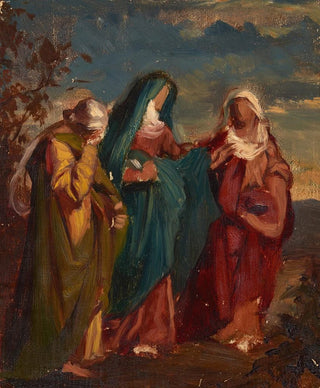Art print | Sketch of the painting Three Marys walking towards the tomb of Christ - Józef Simmler


View from behind

Frame (optional)
In the world of art, certain works manage to capture the very essence of human emotion, and the art print Esquisse du tableau Trois Marie marchant vers le tombeau du Christ - Józef Simmler is a perfect example. This sketch, although a precursor to a larger painting, offers a fascinating glimpse into themes of faith, pain, and hope that traverse the history of religious art. Focusing on this precise moment, Simmler invites us to contemplate the depth of the feelings of the three Marie, emblematic figures of the New Testament, who move forward with a determination tinged with sadness toward the tomb of their master. The scene, both intimate and universal, resonates with a poignant strength that transcends time.
Style and uniqueness of the work
Simmler’s work stands out for its unique approach to chiaroscuro, a technique that emphasizes the contrasts between light and shadow, creating a dramatic atmosphere. In this art print, the figures of the three Marie are rendered with a delicacy that highlights their humanity. The faces, imbued with an expression of devotion mixed with pain, are beautifully modeled, while the drapery of their clothing seems to almost vibrate under the effect of divine light. This attention to detail and texture is characteristic of Simmler’s style, which manages to breathe palpable life into his characters. Furthermore, the use of earthy, subtly nuanced colors enhances the realism of the scene while evoking a deep spirituality, inviting the viewer to an introspective reflection on suffering and resurrection.
The artist and his influence
Józef Simmler, an artist of Polish origin, managed to establish himself in the 19th-century art scene thanks to his exceptional talent and his ability to combine tradition and innovation. Influenced by the masters of classical painting, he also incorporated elements of Romanticism that allowed him to explore more personal and emotional themes. Simmler had a rich career, marked by a deep commitment to religious art, and his work has often been praised for its

Matte finish

View from behind

Frame (optional)
In the world of art, certain works manage to capture the very essence of human emotion, and the art print Esquisse du tableau Trois Marie marchant vers le tombeau du Christ - Józef Simmler is a perfect example. This sketch, although a precursor to a larger painting, offers a fascinating glimpse into themes of faith, pain, and hope that traverse the history of religious art. Focusing on this precise moment, Simmler invites us to contemplate the depth of the feelings of the three Marie, emblematic figures of the New Testament, who move forward with a determination tinged with sadness toward the tomb of their master. The scene, both intimate and universal, resonates with a poignant strength that transcends time.
Style and uniqueness of the work
Simmler’s work stands out for its unique approach to chiaroscuro, a technique that emphasizes the contrasts between light and shadow, creating a dramatic atmosphere. In this art print, the figures of the three Marie are rendered with a delicacy that highlights their humanity. The faces, imbued with an expression of devotion mixed with pain, are beautifully modeled, while the drapery of their clothing seems to almost vibrate under the effect of divine light. This attention to detail and texture is characteristic of Simmler’s style, which manages to breathe palpable life into his characters. Furthermore, the use of earthy, subtly nuanced colors enhances the realism of the scene while evoking a deep spirituality, inviting the viewer to an introspective reflection on suffering and resurrection.
The artist and his influence
Józef Simmler, an artist of Polish origin, managed to establish himself in the 19th-century art scene thanks to his exceptional talent and his ability to combine tradition and innovation. Influenced by the masters of classical painting, he also incorporated elements of Romanticism that allowed him to explore more personal and emotional themes. Simmler had a rich career, marked by a deep commitment to religious art, and his work has often been praised for its






